Characteristics and Meteorological Effects of Ozone Pollution in Spring Season at Coastal City, Southeast China
Abstract
1. Introduction
2. Materials and Methods
2.1. Meteorological and Surface O3 Datasets
2.2. Weather Classification
2.3. Statistical Method
3. Results
3.1. Overview of Regional Ozone Pollution and Meteorological Conditions
3.1.1. Characteristics of O3 Concentrations
3.1.2. Predominant Synoptic Weather Patterns
3.2. Synopticimpacts on Regional Ozone Pollution
3.2.1. Influence of Meteorological Factors on Regional Ozone Pollution
3.2.2. Influence of Vertical Structure on Regional Ozone Pollution
3.3. Quantifying the Contributions of Meteorological Conditions
4. Discussion
- The 90th MDA8 O3 concentration in PT ranged from 118 μg m−3 to 158 μg m−3 with a significantly increasing trend from 2015 to 2020. In the past 6 years, the total number of O3-polluted days was 87 d, and the most occurred in 2017 (35 d). The frequency of O3-polluted days increased from 0.5% in 2015 to 9.6% in 2017, indicating the increasing severity of O3 pollution in the coastal cities in Southeast China. The annual variation of O3 concentrations presents a double-peak pattern, with the peaks appearing in spring and autumn [43,47]. The diurnal variation shows a single-peak pattern, with the peak at 14:00 and the valley at 7:00 [20].
- Based on the weather classification method, five SWPs in total (including Types CU, FS, BB, GS, and GN) were clustered in the springtime from 2015 to 2020. Type FS was associated with low O3 levels due to frequent precipitation. The frequency of O3-polluted days was highest in Type FS (18.6%) and the O3 concentration was also the highest (175 μg m−3), followed by Type BB (10.5%, 174.0 μg m−3), Type GS (9.9%, 174.2 μg m−3), and Type GN (6.3%, 167.0 μg m−3).
- The meteorological mechanisms of O3 pollution under the four SWPs were different. Type FS was associated with weak wind (1.7 m s−1), high RH (69.9%), frequent temperature inversion (100%), weak solar radiation (13.2 MJ m−2), and short sunshine hours (5.4 h). The stable weather along with the convergence of southwest wind and southeast wind near the surface was favorable for pollutants to accumulate in the region. Type GN was associated with strong solar radiation (24.9 MJ m−2), long sunshine hours (10.3 h), and dry air, which promoted the photochemical formation of O3. In addition, the high wind speed was conducive to the regional transport of O3. The strong photochemical reaction was the main reason for the O3 pollution in Type GS and Type BB due to the high temperature (26.3 °C and 41.4 °C, respectively), strong solar radiation (22.4 MJ m−2 and 24.7 MJ m−2, respectively), and long sunshine hours (8.6 h and 9.9 h, respectively).
- The vertical dynamic structure under four SWPs was analyzed. There was zero vertical velocity at the lower level in all four SWPs [45]. There was an ascending motion along with convergence under the height and a sinking motion along with divergence above the height. The vertical structure of divergence at the lower level and convergence at the higher level could lead to the downward transmission of O3 from the stratosphere [46]. The order of the O3 valley values in the four SWPs was consistent with that of downdraft velocity, indicating that a deep sinking motion was the crucial driver for O3 accumulation at night [41].
- Based on the stepwise MLR model, we quantified the meteorological contributions of O3 variations under different SWPs and the developed model captured 60.8% to 80.8% of O3 variations, which were much higher than in other regions [41,42,48]. This indicated the important roles of meteorological conditions in the study area and the difficulties for local governments to reduce O3 pollution.
Author Contributions
Funding
Institutional Review Board Statement
Informed Consent Statement
Data Availability Statement
Acknowledgments
Conflicts of Interest
References
- Li, H.; Peng, L.; Bi, F.; Li, L.; Bao, J.; Li, J.; Zhang, H.; Chai, F. Strategy of coordinated control of PM2.5 and Ozone in China. Res. Environ. Sci. 2019, 32, 1763–1778. [Google Scholar]
- Wang, Y.; Luo, H.; Jia, L.; Ge, S. Effect of particle water on ozone and secondary organic aerosol formation from benzene-NO2-NaCl irradiations. Atmos. Environ. 2016, 140, 386–394. [Google Scholar] [CrossRef]
- Moghani, M.; Archer, C.L.; Mirzakhalili, A. The importance of transport to ozone pollution in the USA Mid-Atlantic. Atmos. Environ. 2018, 191, 420–431. [Google Scholar] [CrossRef]
- Pan, X.; Kanaya, Y.; Tanimoto, H.; Inomata, S.; Wang, Z.; Kudo, S.; Uno, I. Examining the major contributors of ozone pollution in a rural area of the Yangtze River Delta region during harvest season. Atmos. Chem. Phys. 2017, 15, 6101–6111. [Google Scholar] [CrossRef]
- Health Effects Institute. State of Global Air, 2020. In Global Burden of Disease Study, 2019; IHME: Washington, DC, USA, 2020; pp. 1–28. [Google Scholar]
- Fishman, J.; Creilson, J.K.; Parker, P.A.; Ainsworth, E.A.; Vining, G.G.; Szarka, J.; Xu, X. An investigation of widespread ozone damage to the soybean crop in the upper Midwest determined from ground-based and satellite measurements. Atmos. Environ. 2010, 44, 2248–2256. [Google Scholar] [CrossRef]
- Geng, C.; Wang, Z.; Ren, L.; Wang, Y.; Wang, Q.; Yang, W.; Bai, Z. Study on the impact of elevated atmospheric ozone on crop yield. Res. Environ. Sci. 2014, 27, 239–245. [Google Scholar]
- Guohao, L.; Wei, W.; Feng, W.; Shuiyuan, C.; Wei, W.; Gang, W. Diurnal variations of ozone and its precursors and ozone formation potential of VOCs at the boundary of a coking plant during summer and autumn. Chin. J. Environ. Eng. 2014, 8, 1130–1138. [Google Scholar]
- Zapletal, M.; Juran, S.; Krpes, V.; Michna, K.; Cudlin, P.; Edwards, M. Effect of Ozone Flux on Selected Structural andAntioxidant Characteristics of a Mountain Norway Sprude Forest. Balt. Foresrry 2018, 24, 261–267. [Google Scholar]
- Juráň, S.; Grace, J.; Urban, O. Temporal Changes in Ozone Concentrations and Their Impact on Vegetation. Atmosphere 2021, 12, 82. [Google Scholar] [CrossRef]
- Pachauri, R.K.; Reisinger, A. Climate Change 2007:Synthesis Report, Contribution of Working Groups I, II and III to the Fourth Assessment Report of the Intergovernmental Panel on Climate Change. IPCC 2007, 4, 339–343. [Google Scholar]
- China’s Air Quality Improved Significantly (13th Five-Year Period China Impression (11)) [EB/OL]. People’s Daily Online-People’s Daily Overseas Edition, Beijing. Available online: http://sn.people.com.cn/n2/2020/1119/c378287-34424038.html (accessed on 19 August 2022).
- Wang, H.; Zheng, Q.; Wen, Z.; Huang, Y. Influence of ENSO cycle on change of ozone concentration near surface in Fujian province. J. Trop. Meteorol. 2021, 37, 145–153. [Google Scholar]
- Wu, L.; Xue, L.; Wang, W. Review on the observation-based methods for ozone air pollution research. J. Earth Environ. 2017, 8, 479–491. [Google Scholar]
- Liang, Y.; Liu, Y.; Wang, H. Regional characteristics of ground-level ozone in Shanghai based on PCA analysis. Acta Sci. Circumstantiae 2018, 38, 3807–3815. [Google Scholar]
- Wang, T.; Xue, L.; Brimblecombe, P.; Lam, Y.F.; Li, L.; Zhang, L. Ozone pollution in China: A review of concentrations, meteorological influences, chemical precursors, and effects. Sci. Total Environ. 2017, 575, 1582–1596. [Google Scholar] [CrossRef] [PubMed]
- Gong, S.; Zhang, L.; Liu, C.; Lu, S.; Pan, W.; Zhang, Y. Multi-scale analysis of the impacts of meteorology and emissions on PM2.5 and O3 trends at various regions in China from 2013 to 2020 2. Key weather elements and emissions. Sci. Total Environ. 2022, 824, 153847. [Google Scholar] [CrossRef]
- Gong, S.; Liu, Y.; He, J.; Zhang, L.; Lu, S.; Zhang, X. Multi-scale analysis of the impacts of meteorology and emissions on PM2.5 and O3 trends at various regions in China from 2013 to 2020 1: Synoptic circulation patterns and pollution. Sci. Total Environ. 2022, 815, 152770. [Google Scholar] [CrossRef]
- Li, K.; Jacob, D.J.; Liao, H.; Qiu, Y.; Shen, L.; Zhai, S.; Kuk, S.K. Ozone pollution in the North China Plain spreading into the late-winter haze season. Proc. Natl. Acad. Sci. USA 2021, 118, e2015797118. [Google Scholar] [CrossRef]
- Yan, X.; Gou, X.; Yang, J.; Zhao, W.; Xu, Q.; Liu, Y. The variety of ozone and its relationship with meteorological conditions in typical cities in China. Plateau Meteorol. 2020, 39, 416–430. [Google Scholar]
- Yi, R.; Wang, Y.; Zhang, Y.; Zhang, Y.; Shi, Y.; Li, M. Pollution characteristics and influence factors of ozone in Yangtze River Delta. Acta Sci. Circumstantiae 2015, 35, 2370–2377. [Google Scholar]
- Yang, Y.; Hao, J.; Yang, L.; Wang, S.; Zhang, J. Analysis of meteorological conditions of a continuous ozone pollution process in Xingtai of Hebei Province. J. Arid. Meteorol. 2020, 38, 448–456. [Google Scholar]
- Kalabokas, P.; Hjorth, J.; Foret, G.; Dufour, G.; Eremenko, M.; Siour, G.; Beekmann, M. An investigation on the origin of regional springtime ozone episodes in the western Mediterranean. Atmos. Chem. Phys. 2017, 17, 3905–3928. [Google Scholar] [CrossRef]
- Deng, T.; Wang, T.; Wang, S.; Zou, Y.; Yin, C.; Li, F.; Wu, D. Impact of typhoon periphery on high ozone and high aerosol pollution in the Pearl River Delta region. Sci. Total Environ. 2019, 668, 617–630. [Google Scholar] [CrossRef] [PubMed]
- Liu, J.; Wu, D.; Fan, S.; Liao, Z.; Deng, T. Impacts of precursors and meteorological factors on ozone pollution in Pearl River Delta. China Environ. Sci. 2017, 37, 813–820. [Google Scholar]
- Cheng, L.J.; Wang, S.; Gong, Z.Y.; Yang, Q.; Wang, Y.Q. Pollution trends of ozone and its characteristics of temporal and spatial distribution in Beijing-Tianjin-Hebei region. Environ. Monit. China 2017, 33, 14–21. [Google Scholar]
- Hu, Z.; Zhou, G.; Ge, Z.; Wang, J. Ozone pollution assessment and a continuous pollution process analysis in Bengbu. Acta Sci. Circumstantiae 2021, 37, 145–153. [Google Scholar]
- Yang, J.; Zhao, X.; Tao, Y.; Cheng, X.; Xiao, D.; Zhang, C.; Geng, W. Characteristics of ozone weather in Chengdu during summer of 2016–2019. Res. Environ. Sci. 2021, 34, 254–262. [Google Scholar]
- Wang, H.; Lyu, X.; Guo, H.; Wang, Y.; Zou, S.; Ling, Z.; Shen, J. Ozone pollution around a coastal region of South China Sea: Interaction between marine and continental air. Atmos. Chem. Phys. 2018, 18, 4277–4295. [Google Scholar] [CrossRef]
- Zhao, W.; Gao, B.; Liu, M.; Lu, Q.; Ma, S.; Sun, J.; Chen, L.; Fan, S. Impact of meteorological factors on the ozone pollution in Hong Kong. Environ. Sci. 2019, 40, 55–66. [Google Scholar]
- Liu, S.; Cheng, Y.; Li, B.W.; Wang, Y.L.; Xiao, B.; Yan, L.; Liu, S.T. Characteristics of temporal and spatial variations of ozone and it’s influencing factor over Xi’an during 2013–2016. J. Earth Environ. 2017, 8, 541–551. [Google Scholar]
- Liao, Z.; Gao, M.; Sun, J.; Fan, S. The impact of synoptic circulation on air quality and pollution -related human health in the Yangtze River Delta region. Sci. Total Environ. 2017, 607–608, 838–846. [Google Scholar] [CrossRef]
- Liang, Z.; Gu, T.; Yang, X.; Zhong, H.; Qi, B. Study on circulation classification based surface ozone concentration predictionmodel. China Environ. Sci. 2017, 37, 4469–4479. [Google Scholar]
- Otero, N.; Sillmann, J.; Schnell, J.L.; Rust, H.W.; Butler, T. Synoptic and meteorological drivers of extreme ozone concentrations over Europe. Environ. Res. Lett. 2016, 11, 024005. [Google Scholar] [CrossRef]
- Wang, H.; Zheng, Q.; Hong, Z.; Huang, Y. Analysis of a springtime high surface ozone event over Fujian coastal areas. Res. Environ. Sci. 2020, 33, 36–43. [Google Scholar]
- Zhu, J.; Chen, L.; Liao, H.; Dang, R. Correlations between PM2.5 and ozone over China and associated underlying reasons. Atmosphere 2019, 10, 352. [Google Scholar] [CrossRef]
- Wang, Z.B.; Li, J.X.; Liang, L.W. Spatio-temporal evolution of ozone pollution and its influencing factors in the Beijing-Tianjin-Hebei Urban Agglomeration. Environ. Pollut. 2019, 256, 113419. [Google Scholar] [CrossRef]
- Huang, X.G.; Shao, T.J.; Zhao, J.B. Spatio-temporal differentiation of ozone concentration and its driving factors in Yangtze River Delta urban agglomeration. Resour. Environ. Yangtze Basin 2019, 28, 1434–1445. [Google Scholar]
- Huth, R.; Beck, C.; Philipp, A.; Demuzere, M.; Ustrnul, Z.; Cahynová, M.; Kyselý, J.; Tveito, O.E. Classifications of atmospheric circulation patterns: Recent advances and applications. Ann. N. Y. Acad. Sci. 2008, 1146, 105–152. [Google Scholar] [CrossRef] [PubMed]
- Renhe, Z.; Li, Q.; Zhang, R. Meteorological conditions for the persistent severe fog and haze event over eastern China in January 2013. Sci. China Earth Sci. 2014, 44, 27–36. [Google Scholar] [CrossRef]
- Mao, J.; Wang, L.; Lu, C.; Liu, J.; Li, M.; Tang, G.; Ji, D.; Zhang, N.; Wang, Y. Meteorological mechanism for a large-scale persistent severe ozone pollution event over eastern China in 2017. J. Environ. Sci. 2020, 92, 187–199. [Google Scholar] [CrossRef] [PubMed]
- Liu, J.; Wang, L.; Li, M.; Liao, Z.; Sun, Y.; Song, T.; Gao, W.; Wang, Y.; Li, Y.; Ji, D.; et al. Quantifying the impact of synoptic circulation patterns on ozone variability in northern China from April to October 2013–2017. Atmos. Chem. Phys. 2019, 19, 14477–14492. [Google Scholar] [CrossRef]
- Pu, Y.; Wu, S.; Ye, L.; Gao, L.; Wang, W. Variation characteristics and meteorological factors of ozone concentration in the urban area of Jiangmen. J. Trop. Meteorol. 2020, 36, 650–659. [Google Scholar]
- Liao, G.; Zheng, F.; Zeng, P.; Mo, Y. Weather types of haze days in Guangxi. Meteorol. Sci. Technol. 2018, 46, 149–153. [Google Scholar]
- Wu, J.; Li, C.; Ma, Z.Q.; Sun, Z.B.; Zhu, X.W.; Dong, F. Influence of meteorological conditions on ozone pollution at Shangdianzi station based on weather classification. Environ. Sci. 2020, 11, 4864–4873. [Google Scholar]
- Zhao, K.; Bao, Y.; Huang, J.; Zhang, X.; Liu, C.; Qi, H.; Xu, W. A modeling study of the impact of stratospheric intrusion on ozone enhancement in the lower troposphere in South China. Chin. J. Atmos. Sci. 2019, 43, 75–86. [Google Scholar] [CrossRef]
- Chen, L.; Xiao, H.; Zhu, L.; Guo, X.; Wang, W.; Ma, L.; Guo, W.; He, J.; Wang, Y.; Li, M.; et al. Characteristicsof Ozone Pullution and the Impacts of Related Meteorological Factors in Shanxi Province, China. Atmosphere 2022, 13, 1729. [Google Scholar] [CrossRef]
- Zhao, W.; Fan, S.; Guo, H.; Gao, B.; Sun, J.; Chen, L. Assessing the impact of local meteorological variables on surface ozone in Hong Kong during 2000–2015 using quantile and multiple line regression models. Atmos. Environ. 2016, 144, 182–193. [Google Scholar] [CrossRef]
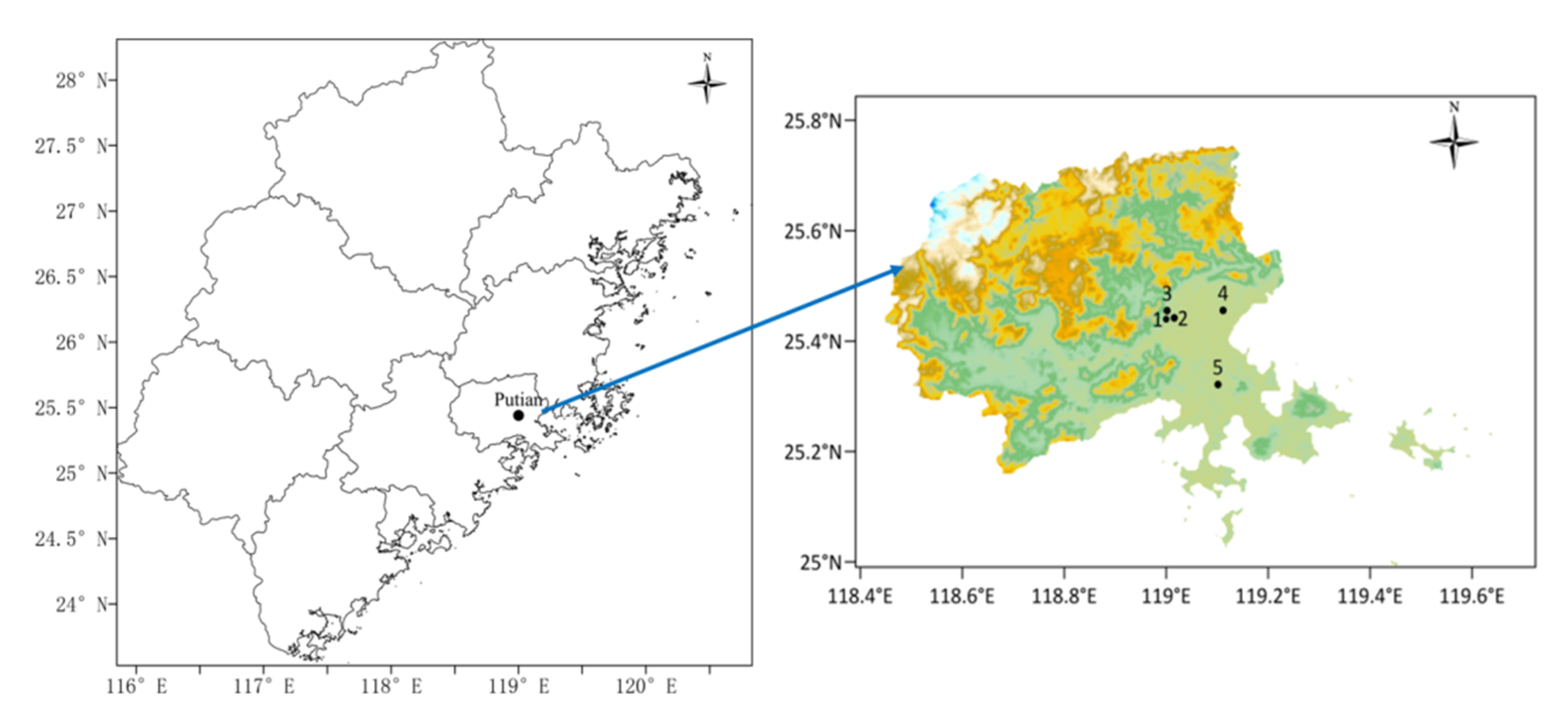
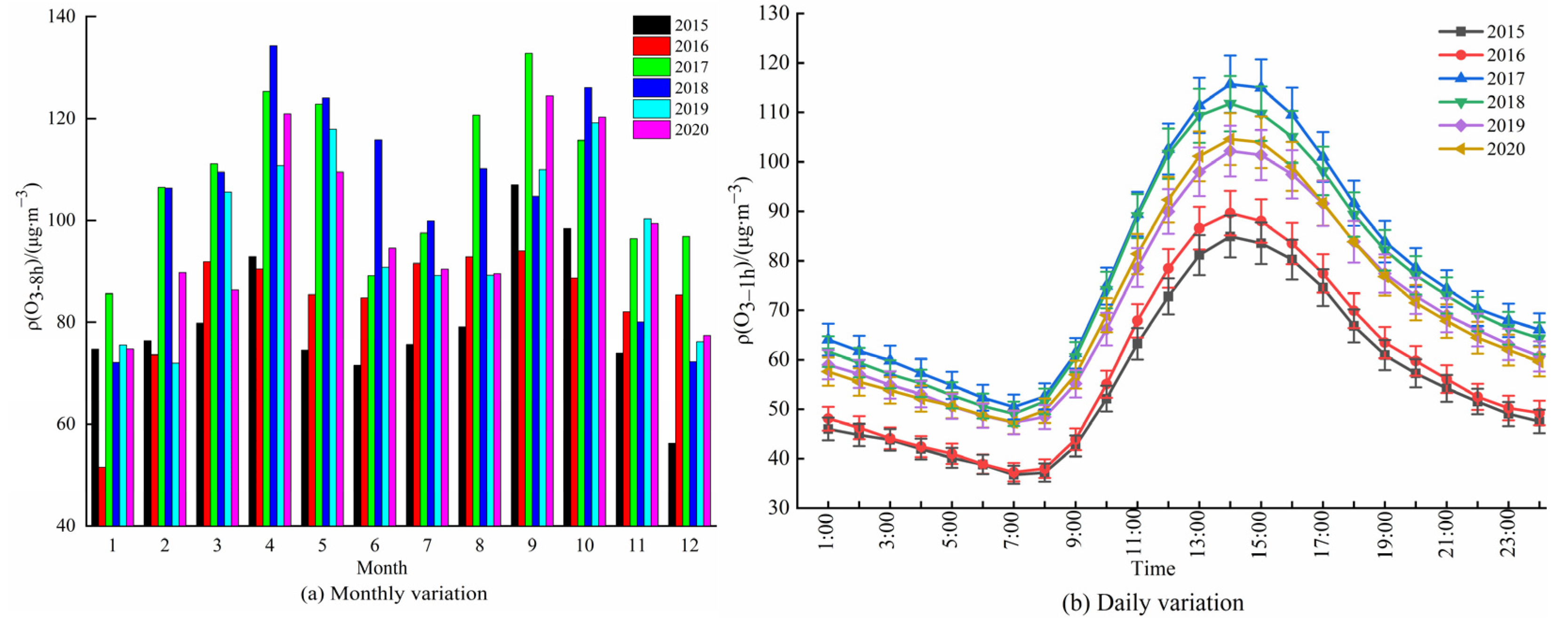
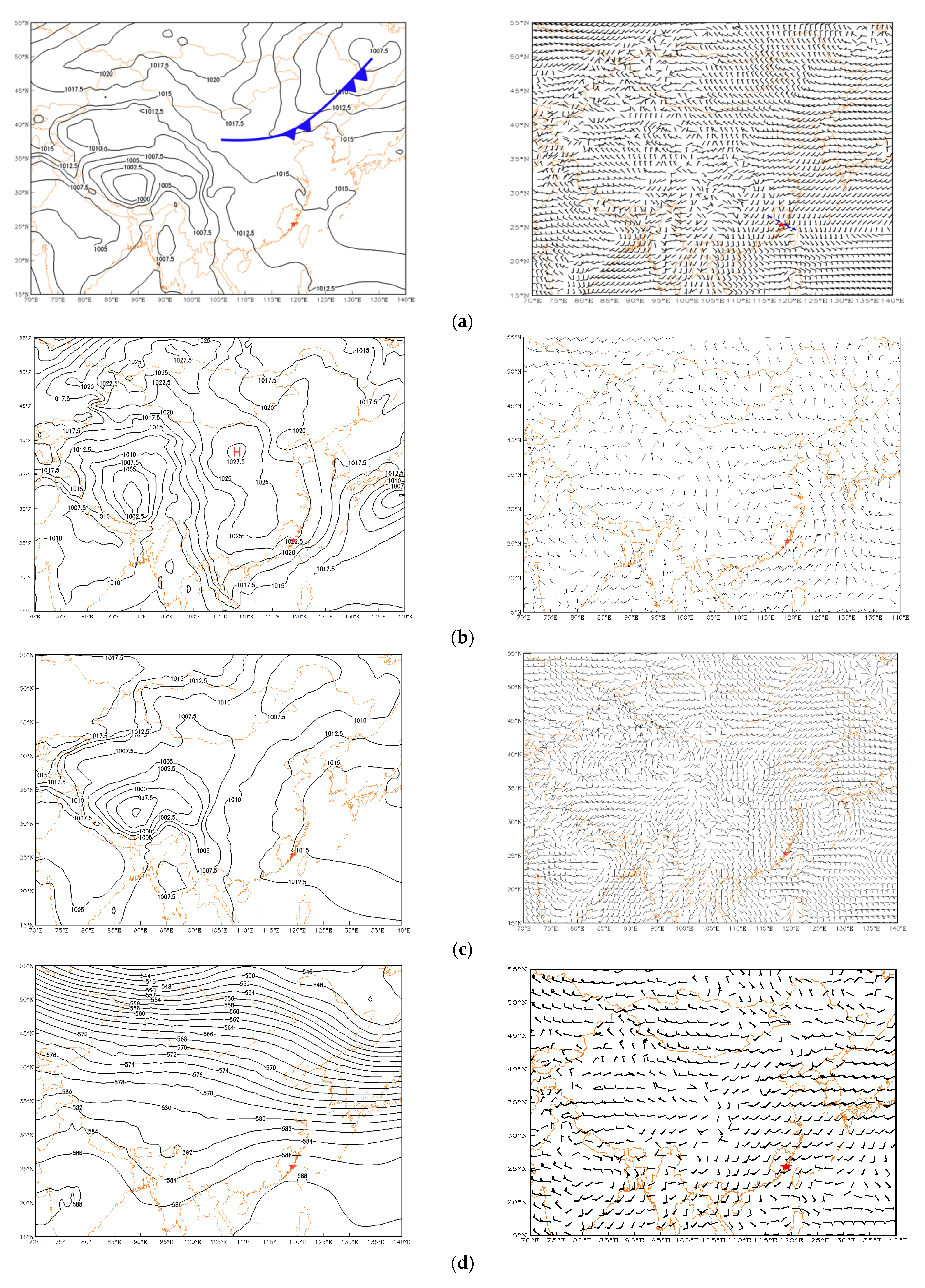
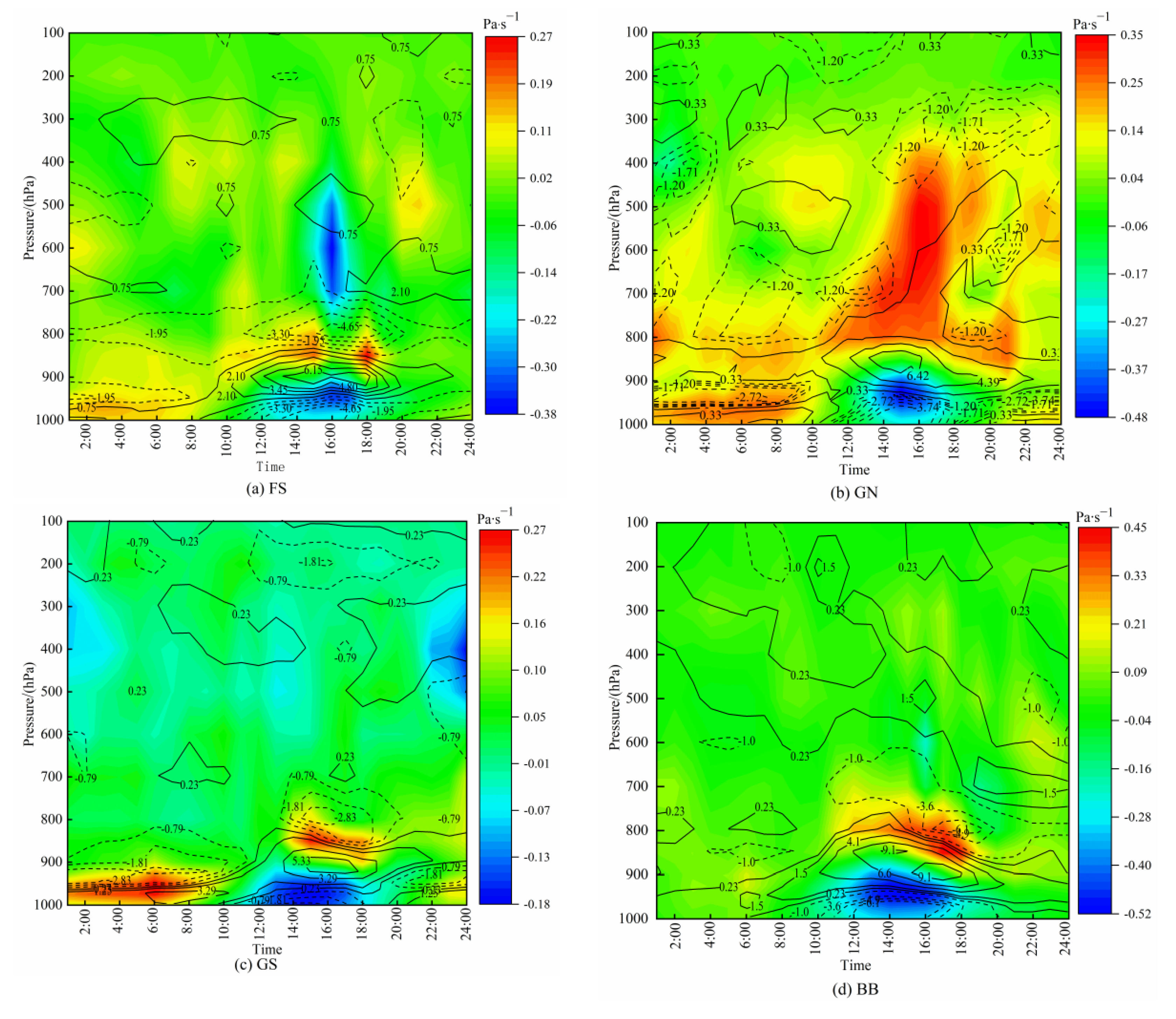
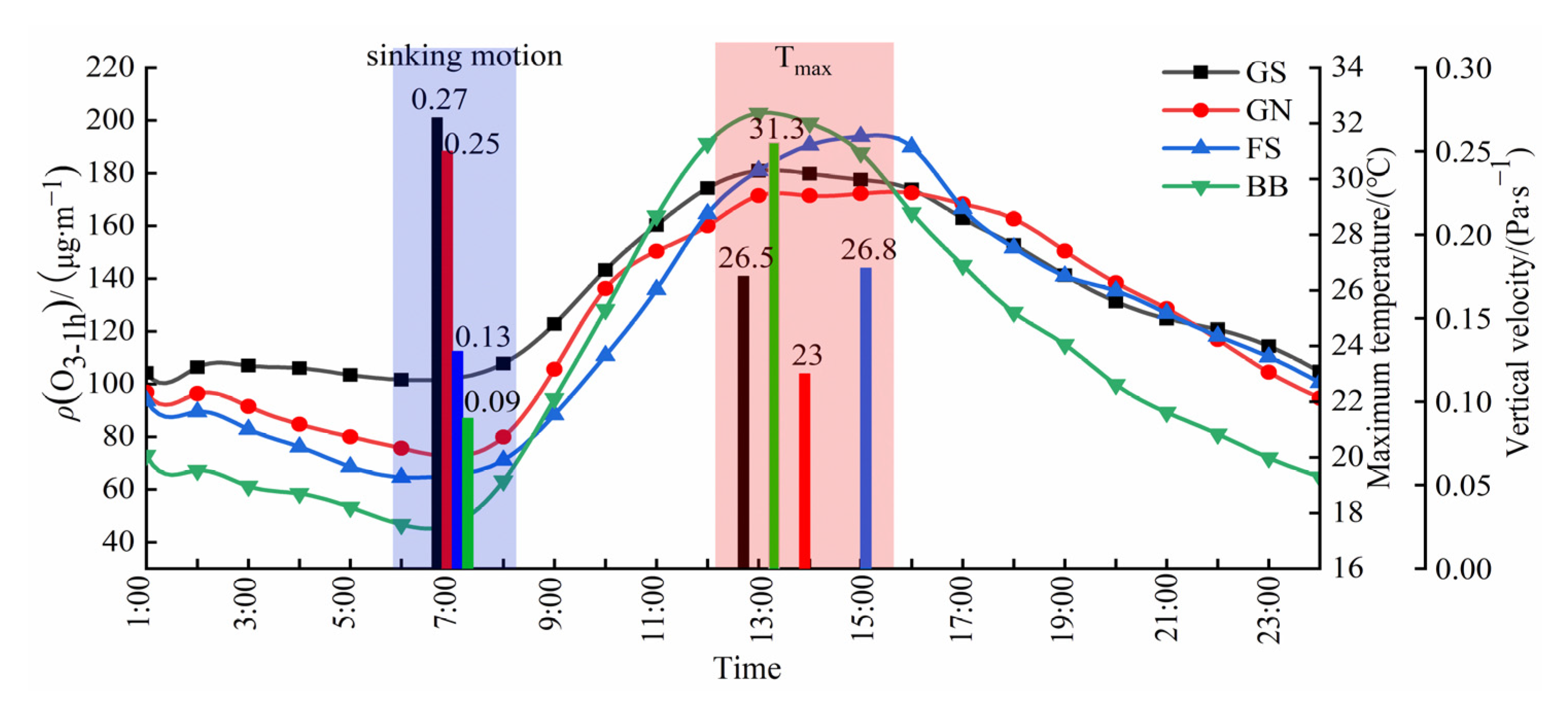

| Year | Maximum MDA8 O3 (μg m−3) | Minimum MDA8 O3 (μg m−3) | O3 Polluted Days (d) | Frequency of O3 Pollution (%) | 90th MDA8 O3 (μg m−3) |
|---|---|---|---|---|---|
| 2015 | 10 | 183 | 2 | 0.5 | 118 |
| 2016 | 7 | 191 | 7 | 1.9 | 129 |
| 2017 | 14 | 216 | 35 | 9.6 | 158 |
| 2018 | 11 | 210 | 25 | 6.8 | 156 |
| 2019 | 24 | 174 | 7 | 1.9 | 138 |
| 2020 | 30 | 187 | 11 | 3.0 | 140 |
| Type | Number of Days (d) | Number of O3 Polluted Days (d) | Frequency of O3 Polluted Days (%) | MDA8 O3 during Polluted Days (μg m−3) |
|---|---|---|---|---|
| Type FS | 59 | 11 | 18.6 | 176.5 |
| Type GN | 95 | 6 | 6.3 | 167.0 |
| Type GS | 152 | 15 | 9.9 | 174.2 |
| Type BB | 28 | 4 | 10.5 | 174.0 |
| Type CU | 208 | 0 | 0 | - |
| Total | 552 | 36 | 6.5 | 173.6 |
| Type | Tmax (°C) | WS (m s−1) | RH (%) | TP (mm) | SR (MJ m−2) | SH (h) | TI |
|---|---|---|---|---|---|---|---|
| Type FS | 26.3 | 1.7 | 69.9 | 9.1 | 13.2 | 5.4 | 11/11 |
| Type GN | 22.5 | 2.1 | 54.1 | 0 | 24.9 | 10.3 | 5/6 |
| Type GS | 26.3 | 1.9 | 61.2 | 0 | 22.4 | 8.6 | 9/15 |
| Type BB | 31.4 | 2.0 | 72.8 | 0 | 24.7 | 9.9 | 4/4 |
| Type | Equation | RE2 (%) |
|---|---|---|
| FS | O3 = 8.415 WS − 1.72 RH + 9.056 Tmax + 3.309 P − 18.511 SH + 3289.292 | 71.1 |
| GN | O3 = 7.498 WS − 0.809 RH + 8.07 Tmax − 26.563 SH − 0.001 V + 38.255 | 80.6 |
| GS | O3 = 8.276 WS − 0.668 RH + 5.268 Tmax + 1.292 P − 7.378 SH − 1258.57 | 60.8 |
| BB | O3 = 22.712 WS − 2.169 RH + 7.617 Tmax + 10.057 P − 32.607 SH − 10029.816 | 80.8 |
Publisher’s Note: MDPI stays neutral with regard to jurisdictional claims in published maps and institutional affiliations. |
© 2022 by the authors. Licensee MDPI, Basel, Switzerland. This article is an open access article distributed under the terms and conditions of the Creative Commons Attribution (CC BY) license (https://creativecommons.org/licenses/by/4.0/).
Share and Cite
Ren, S.; Ji, X.; Zhang, X.; Huang, M.; Li, H.; Wang, H. Characteristics and Meteorological Effects of Ozone Pollution in Spring Season at Coastal City, Southeast China. Atmosphere 2022, 13, 2000. https://doi.org/10.3390/atmos13122000
Ren S, Ji X, Zhang X, Huang M, Li H, Wang H. Characteristics and Meteorological Effects of Ozone Pollution in Spring Season at Coastal City, Southeast China. Atmosphere. 2022; 13(12):2000. https://doi.org/10.3390/atmos13122000
Chicago/Turabian StyleRen, Saisai, Xiaoting Ji, Xiangliang Zhang, Meimei Huang, Hong Li, and Hong Wang. 2022. "Characteristics and Meteorological Effects of Ozone Pollution in Spring Season at Coastal City, Southeast China" Atmosphere 13, no. 12: 2000. https://doi.org/10.3390/atmos13122000
APA StyleRen, S., Ji, X., Zhang, X., Huang, M., Li, H., & Wang, H. (2022). Characteristics and Meteorological Effects of Ozone Pollution in Spring Season at Coastal City, Southeast China. Atmosphere, 13(12), 2000. https://doi.org/10.3390/atmos13122000





